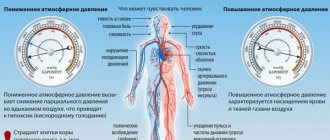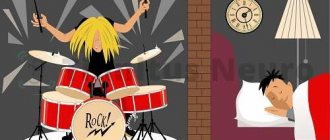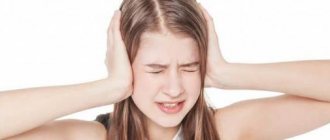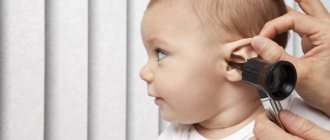Ear pressure
Often adults and children complain of pressure in the ears. This symptom does not occur in isolation, but is combined with other unpleasant phenomena. Patients may notice bursting headaches, a feeling as if someone is pressing on the ears from the inside, hearing impairment, distortion of sounds (aberrations), phantom sounds, inappropriate perception of sounds as very sharp or muffled, loss of coordination of movements, etc.
Often the causes of such symptoms are:
- otitis;
- otosclerosis;
- arterial hypertension;
- increased intracranial pressure;
- osteochondrosis of the cervical spine;
- tumors of the auditory nerve;
- ear plugs.
Problems with such complaints have to be resolved with specialists such as ENT, therapist, neurologist.
Otitis media is called inflammation of the middle ear. If there is pressure in the ears and there are signs of inflammation: chills, fever, general weakness, and when shooting pains appear in the ear, inflammation of the middle ear can be assumed. In total, a person is distinguished:
Diagnosis of otitis media in a patient
- external ear - consists of the external auditory canal and the auricle;
- the middle ear with a sound transmitting device - the tympanic cavity, consisting of the malleus, incus and stirrup;
- inner ear - with a membranous labyrinth in the cavity of the bony labyrinth of the temporal bone.
The middle ear has an opening that continues into the Eustachian tube, which connects the ear cavity to the pharynx. This anatomical formation sometimes serves as a channel for the spread of infection. With inflammation of the middle ear, fluid accumulates in the tympanic cavity, which creates a feeling of pressure in the ears . In a healthy person, the contents of the tympanic cavity flow out through the Eustachian tube, however, inflammatory processes can lead to temporary blockage of this opening, and then the accumulating serous or purulent exudate puts pressure on the ears from inside the tympanic cavity, leading to a rupture of the eardrum.
If you feel pressure in the ear, the symptoms of which are complemented by fever, shooting pains and fever, you should urgently consult an ENT doctor. Otitis is more severe if tonsillitis, pharyngitis, and laryngitis are added, since these diseases provoke inflammation and swelling of the Eustachian tube, leading, on the one hand, to infection of the middle ear, and on the other, complicating the outflow of exudate.
As the inflammation subsides, the patency of the Eustachian tube is restored, the eardrum heals, and the inflammation subsides. Throughout the course of the disease, from onset to recovery, hearing loss may occur. Sometimes complications occur, and inflammation breaks into the mastoid process. The coverage of other anatomical areas by the infectious process can be assessed using computed tomography.
How to get rid of ear pressure
Acute otitis media can be caused by pneumococci and Haemophilus influenzae, and if the process is active, then antibiotic therapy is started. Use:
- "Amoxiclav";
- cephalosporins, including Cefepime, Cefotaxime, Ceftaroline fosamil;
- fluoroquinolones, including Levofloxacin, Moxifloxacin and other drugs.
The dose is calculated taking into account body weight if we are talking about a child.
Antibiotic therapy is supplemented with physiotherapy: iontophoresis using iodine, zinc, bromine. UHF therapy and eardrum massage are performed . At the same time, nasal patency is restored and inflammation in adjacent anatomical cavities is treated: pharynx, larynx, nasal cavity.
Sometimes they resort to surgery. It consists of installing a drainage tube in the middle ear cavity and removing it through the eardrum: thus, exudate does not accumulate and does not excessively injure the eardrum.
What to do if there is pressure from inside the ears
Of course, just consult a doctor. The causes of ear pain listed above are a threat to human life if they are not eliminated in time.
Whatever the cause of the pressing pain inside the ear, you need to see a doctor immediately! The ear is an important human organ. Hearing loss will dramatically reduce your standard of living, however, based on the above, hearing loss is not the worst thing that ear pain can cause. Pressure in the ears can be a persistent warning of the development of serious diseases, such as increased blood pressure or thrombosis of the arteries with atherosclerotic plaque. Delay in seeing a doctor can cost you not only hearing loss, but also loss of life. Take care of yourself and do not self-medicate.
Increased intracranial pressure
Sometimes there is a combination of pressure in the head and ears, and this can be a sign of increased intracranial pressure. This condition causes an excess amount of cerebrospinal fluid to circulate in the ventricles of the brain, the space between the skull and brain, and in the spinal canal. There are two mechanisms for the formation of cerebrospinal fluid . In one case, cerebrospinal fluid is produced in the ventricles of the brain by glandular cells - approximately 70% of cerebrospinal fluid is produced in this way. Another way is to sweat the liquid part of the blood from the vessels into the cavity of the ventricles of the brain - this replenishes the cerebrospinal fluid by another 30%. The reverse outflow of cerebrospinal fluid occurs through the venous sinuses of the arachnoid membrane of the brain.
Increased intracranial pressure
The reasons are extremely varied and the main ones include:
- congenital hydrocephalus (pathology of the venous sinuses);
- infectious lesions (meningitis, encephalitis, etc.);
- difficult birth (umbilical cord entanglement);
- taking oral contraceptives;
- infectious diseases outside the cranial cavity;
- tumor processes in the brain;
- stroke;
- taking certain medications.
The volume of therapy depends on the severity of intracranial hypertension, which is measured by puncture with a needle with a pressure gauge: during puncture, the pressure of the cerebrospinal fluid is determined. These measures are complemented by computed tomography, MRI, EEG, and fundus examination.
Intracranial hypertension is relieved by taking diuretics: Furosemide, Diacarb, etc. Glucocorticoids are added, as they reduce exudative processes. Drug therapy is supplemented with massage, wearing a magnetic collar, a circular shower, acupuncture, etc. If there is an infectious component, then antibiotics are added. Sometimes it is necessary to resort to cerebral shunting with the shunt inserted into the pericardial cavity or abdominal cavity; an alternative would be a therapeutic puncture.
Treatment
Depending on the cause of pressure in the ears, medical specialists will prescribe treatment:
- For inflammatory diseases, broad-spectrum antibiotics are prescribed in the form of:
- tablets for oral administration (“Ciprofloxacin”, “Augmentin”, “Azithromycin”, “Ofloxacin”);
- ear drops (Tobrex, Ofloxacin, Tsipromed).
- In case of circulatory disorders, antispasmodics, nootropic drugs, and agents that improve blood flow and vascular tone are prescribed.
- Attacks of pain during migraine are relieved with painkillers (Ketorol, Imet, Nurofen).
- For hypertension and increased intracranial pressure, first of all, you need to reduce your blood pressure. Diuretics and antihypertensive drugs of different groups are used.
- For hypotension, medications are used that increase vascular tone (tincture of eleutherococcus, ginseng, lemongrass).
- If the cause is a neoplasm, its removal, as well as the feasibility of such intervention, is handled by an oncologist. Chemotherapy, radioactive surgery, and surgery are applicable.
- If, due to inflammatory diseases of the ears and nose, a lot of pus has accumulated behind the eardrum, it can be removed during excision of the membrane. This operation is minimally invasive, painless and will immediately help relieve pressure in the ears.
Traditional methods of therapy are often not used when there is a feeling of pressure in the ears. Since such therapy is dangerous and ineffective. You must coordinate any methods with your doctor. You should not self-medicate - you need to contact a specialist.
Arterial hypertension
Increased intracranial pressure with arterial hypertension may be a consequence of excessive sweating of the liquid part of the blood in the ventricles of the brain. But sensations of pressure can also cause increased tone and congestion of cerebral vessels . Headaches and bloating in this case correlate with an increase in total systolic and diastolic pressure. Measuring blood pressure allows you to understand what's going on.
Why can ears become blocked?
It would be advisable to take diuretics, beta blockers, and calcium antagonists. A person should be reassured if the jump occurred due to stress.
Symptoms accompanying the sensation of squeezing in the ears
Symptoms can occur in any age category of the patient - both in a child and in an elderly person. The feeling of pressure in the ears is provoked by a huge number of factors, but what exactly is the cause of this phenomenon can only be determined by the symptoms accompanying the disease:
2) Pressing sensation in the auditory organs. There is also a feeling that the head is being burst from the inside, and there is very strong pressure on the eardrums. Such symptoms cause not only discomfort, but also unbearable pain. A person may feel nauseous and be haunted by headaches varying in intensity: from tolerable pain in the temporal or occipital part, to acute migraine, when any slight movement causes suffering;
3) Different sounds appear in your head. Sometimes they are insignificant for perception, but in some cases they are simply unbearable. This makes the patient irritable and nervous, causing sleep disturbances;
4) Feeling dizzy not only during physical activity, but also in a calm state if a person changes body position;
5) Nausea appears regularly or spasmodically, often without the urge to vomit;
6) Loud sounds become simply impossible to bear;
 Negative reaction to bright light;
Negative reaction to bright light;
9) Distorted sound perception;
10) Ghostly sounds appear that did not actually exist (for example, the whistling of a kettle, knocking on doors, etc.).
If the symptoms are complex and cause discomfort for more than one day, you should immediately go to a specialist and undergo the necessary examination. An otolaryngologist will not be able to determine in every case what is causing the pressure on the ears from the inside. The reasons for this may be hidden in diseases of the nervous, cardiovascular and other systems, so there may be a need to be examined by other specialists.
Osteochondrosis
Symptoms in the head area can be caused by osteochondrosis of the cervical spine. The manifestation of the disease itself is caused by compression of the nerve roots due to subsidence of the intervertebral cartilaginous disc. In this case, the following may be observed:
- noise in ears;
- feeling of pressure in the head;
- pain along the roots, radiating to the areas they innervate;
- local numbness of body parts.
Osteochondrosis, once it begins, never completely goes away, since it is a consequence of age-related degeneration of cartilage. However, it is possible to relieve its symptoms and restore functional activity to the affected parts of the body. Massage, the use of anti-inflammatory drugs, physiotherapy, and gymnastics help with osteochondrosis. Non-traditional health practices often help: qigong and yoga, which are rich in isometric exercises that improve local blood flow. However, the volume and nature of these exercises should be determined by the attending physician so as not to worsen the situation.
A symptom such as pressure in the ears is observed quite often, and the mechanisms of its occurrence can be varied. If it does not go away and is accompanied by additional symptoms, then you should not ignore it. Most likely, you will not be able to determine the source of the problems yourself . This should be done by a qualified doctor, since only he can include in the diagnostic process not only his professional skills, but also the entire complex of laboratory and instrumental procedures that allow him to establish the exact cause of the complaints.
Rare causes
In addition to the already discussed frequently occurring reasons for this phenomenon, there are others - more rare, but, nevertheless , also occurring and quite real. Let's find out what these reasons are.
- Anatomical pathologies of the auditory organs. Sometimes congenital abnormalities of the hearing organs lead over time to the appearance of compression in the ears from the inside.
- Diseases such as adenoids, the growth of polyps, and various types of tumors lead to an increase in deformed soft mucosal tissue, which puts pressure on the blood vessels, causing an unpleasant symptom. The link describes the treatment of adenoiditis.
- Sometimes changes in atmospheric pressure can play a cruel joke on weather-dependent people, causing them an uncomfortable state of internal pressure in the temples and ears.
- Flying on an airplane , diving, riding a merry-go-round and some other types of activities can lead to the appearance of so-called aerootitis, one of the signs of which is a feeling of squeezing in the ears from the inside. By the way, in this case you can get rid of this unpleasant feeling quite simply: you just need to suck a lollipop or chew gum.
- Eustachitis - inflammation of the mucous membrane of the tube of the same name can also lead to the appearance of this symptom. This, by the way, is a very alarming diagnosis. It is necessary to take treatment measures as soon as possible, otherwise complete hearing loss is possible. The link describes in detail the treatment of eustachitis.
- In a hypertensive crisis, complete blocking of the ears occurs, but this goes away when the threat of a stroke is relieved.
- Water ingress can also cause an unpleasant symptom in the form of a feeling of pressure in the ears. Therefore, it is necessary to carefully get rid of any spilled water after swimming, and to swim in the pool wearing a rubber cap.
In the video why there is pressure on the ears from the inside:
Why is there pressure on the inside of the ears and a headache?
There can be many reasons for pressure, and it is not always possible to detect them on your own. They can be harmless or indicate various diseases. Most often, this condition is not a pathology:
- Pressure in the ears may be caused by wax plugs. It occurs without pain, but there is a constant feeling that something is stuck in the ear. This prevents a person from concentrating and distracts him from his usual activities.
- A feeling of fullness in the ears can be caused by swelling of the auditory tube.
- An unpleasant symptom can be caused by listening to loud music for a long time, especially with headphones.
Natural factors that lead to ear congestion include: flying on an airplane, taking an elevator, diving into deep water, climbing mountains.
Some people with a weakened vestibular system experience a feeling of pressure when traveling on the subway. It passes immediately after the train stops. To avoid unpleasant sensations, you need to slightly open your mouth while moving.
Let's also consider diseases in which one of the symptoms is congestion and pressure in the ears.
Migraine
Migraine attacks appear suddenly under the influence of certain factors - drinking alcohol, smoking, prolonged exposure to the sun, stressful situations. A sharp pain appears in the head, which is pulsating and very intense. It spreads to the eyes, cheekbones, and temples.
During severe attacks, pressure in the ears may occur. The unpleasant symptom intensifies when the head is tilted, as well as when the body is lying down.
Painkillers help reduce pain, but their effect does not last long. Attacks can last from several hours to several days. Sometimes there are several attacks at once, appearing one after another.
Cervical osteochondrosis
With cervical osteochondrosis, blood circulation to the brain is disrupted. Due to the lack of oxygen, some unpleasant symptoms appear - severe headaches, dizziness. They can be almost unnoticeable during the day and intensify towards the end of the day, especially after physical activity. When a person goes to bed, he may hear a noise in his head and feel a throbbing pain behind his ears. Such sensations can haunt him throughout the day, he simply does not pay attention to them, as he is busy with other things.
The disease is also accompanied by weakness, drowsiness, lethargy, and decreased ability to work. Without treatment, pain in the neck, shoulders, and vision problems may occur. Over time, the pathology leads to poor posture and abnormal gait.
Sinusitis
Inflammation of the maxillary sinuses can also lead to ear pressure. Sinusitis can appear as a result of hypothermia, chronic rhinitis, allergic rhinitis. Due to inflammation, the natural passages swell and become blocked, which disrupts the process of mucus removal. As a result, pus accumulates in the nose. Gradually, it completely fills the sinuses, which put pressure on the auditory tube, leading to its swelling. This causes a person to complain of tinnitus.
With sinusitis, headaches in the frontal region are also observed. They intensify with pressure and with any head movements.
To relieve symptoms, it is not recommended to apply heat to the maxillary sinuses. This increases blood circulation, so the inflammatory process can become even more pronounced.
Atherosclerosis
Due to a sedentary lifestyle, excessive consumption of alcoholic beverages, and poor nutrition, cholesterol levels in a person’s blood can increase. The vessels wear out and become fragile, and atherosclerosis appears. The disease is more often observed in older people, and also develops against the background of diabetes mellitus .
Blood circulation to the brain is impaired. This creates a feeling that there is pressure on the ears from the inside. The patient compares this symptom with the sensations that arise when flying on an airplane. Only they are permanent.
Purulent otitis media
In most cases, otitis media appears as a complication of untreated sinusitis or a cold. May occur due to hypothermia and draft.
An inflammatory process begins in the middle ear area. An excessive amount of pus accumulates, which puts pressure on the eardrum. The pathology is accompanied by severe pain, as if there is a knocking in the ear. Sometimes lumbago is observed - the pain is so pronounced that it is impossible to restrain emotions. There is a feeling that there is a buzzing, noise and pressure in the ear - like when water gets into it.
High blood pressure
Unpleasant sensations appear only in cases where blood pressure rises. In addition to a feeling of pressure in the ears and headaches, a person notes weakness, drowsiness and dizziness. The discomfort goes away after taking a medication that lowers blood pressure.
The same symptoms are observed with high intracranial pressure. But in this case, symptoms appear more often and are more pronounced.
Causes
Let's consider the possible reasons why there is pressure on the ears from the inside.
Migraine
Migraine is a dysfunction of the body of a neurological nature. Most often, migraine manifests itself in regularly occurring episodes of severe headaches that torment a person. The etiology of migraine has not been fully elucidated. Presumably, predisposing factors for migraine, which causes a feeling of pressure in the ears, are:
- genetics;
- neuroses;
- increased stress levels;
- overvoltage;
- eating certain foods that provoke the occurrence of this disease;
- drinking alcohol;
- weather dependence.
Migraine is not accompanied by any other deterioration of a person’s condition, as a rule: there have been no previous blows to the head, concussion, increased pressure in the blood vessels or eye diseases that radiate to the head.
With migraine, there is a narrowing of the blood vessels in the brain, their uneven expansion, and impaired perception of CO2. The risk of migraines increases if relatives suffer from high blood pressure.
Migraines are characterized by throbbing pain inside the head and pressing pain in the ear. As a rule, the pain is long-lasting, from four hours to three days. Most often, only one half of the head is affected, although, in severe cases, the entire head may hurt. With migraine, pressing pain is felt only in one ear on the affected side. Most often the pain is felt on the outside of the ear.
Hypertension
Hypertension can cause a feeling of pressure in the ears. Arterial hypertension is characterized by a prolonged increase in blood pressure above the following units: siastolic - above 140, and diastolic - above 90 mmHg. There are many reasons for such a sharp change in pressure:
- taking dietary supplements;
- obesity;
- taking oral contraceptives;
- stress;
- overwork;
- loads that are not comparable with age;
- smoking;
- high blood sugar;
- menopause;
- hereditary predisposition.
Symptoms of arterial hypertension are:
- sudden increase in blood pressure;
- loss of strength, change in complexion;
- perspiration;
- blurred vision;
- patients complain of pain in the back of the head;
- sudden anxiety may occur;
- heart rate increases;
- causeless fear arises;
- often dizziness, fainting;
- pain in the ears is of a pressing nature, with ringing or squeaking, tinnitus, hearing impairment - like deafness.
Atherosclerosis
Atherosclerosis is another possible cause of ear pressure. This is a disease characterized by impaired metabolism of fats and proteins, resulting in deposits of cholesterol and some types of fats on the walls of blood vessels. Such deposits are called atherosclerotic plaques. The formation of atherosclerotic plaques leads to blockage of blood vessels, and, as a consequence, to disruption of blood flow to the organs.
Causes of atherosclerosis:
- smoking;
- poor nutrition;
- obesity;
- diabetes;
- sedentary lifestyle;
- drunkenness;
- dysfunction of the thyroid gland;
- menopause;
- poor family history.
Atherosclerosis does not have the ability to develop in a specific organ, and if it has already appeared in the human body, it affects all the vessels of the body. Atherosclerotic plaques penetrate the endothelium of the vessel, and, having the ability to break away from the walls, can lead to rupture of the vessel and subcutaneous hemorrhages. In addition, a detached plaque can simply clog a vessel, completely blocking blood access to a certain human organ. Affecting the vessels of the head and neck, it gradually reaches smaller vessels - the vessels of the ear. By disrupting the blood flow to the ear, it leads to the ear tissue not receiving enough oxygen and necessary substances. The patient may feel that the head is bursting from the inside and the ears are blocked; there is a feeling that there is pressure in the ear.
Otitis media is a disease of the hearing organ. There is inflammation of the outer, middle and inner ear. Most often, children are susceptible to otitis media, but adults suffer from it not much less often.
- Inflammation of the outer ear is usually associated with the appearance of a boil in the auricle. Bursting, pressing pain inside the ear in this case is explained by the development of purulent inflammation of the boil. In addition, a person may feel heat in the ears, pain when touching the ear, and tugging pain in the ear. It’s painful to sleep at the cause site, it’s impossible to touch, even straighten your hair. Discomfort persists until the boil breaks out. The inflammatory process can even spread to the eardrum, leading to hearing impairment.
- Inflammation of the middle ear may be purulent, or may not develop into this stage. A person can suffer from inflammation of the middle ear constantly (in chronic form), or temporarily, episodicly and acutely. It is characterized by fever, suppuration from the ear, pressing, bursting pain inside the ear and head. As a rule, otitis media is bacterial in nature. Bacteria can enter the middle ear through the nasal passage in the presence of sinusitis. The hematological route of infection is also possible - through the eardrum. Otitis media can develop with the flu, then bloody discharge will be observed from the ear. And also with scarlet fever, in which case the suppuration will be very profuse, and the pain in the ear will be very severe.
Diagnostics
Diagnosis of the disease may require consultation with various specialists - a therapist, a traumatologist, a neurologist, an ENT specialist. First of all, you should contact your therapist and describe your disturbing symptoms as accurately as possible. He can make a diagnosis himself or refer you to other specialists.
During diagnosis, laboratory and instrumental methods can be used:
- Ultrasound of the cervical spine. It can be used to determine the condition of blood vessels. The study shows a circulatory disorder.
- Blood chemistry. Shows cholesterol level.
- General blood test. With its help, you can determine the inflammatory process in the body. Effective for sinusitis and otitis media.
- CT or MRI of the brain. During the examination, circulatory disorders, as well as various neoplasms, can be seen.
- X-ray of the cervical spine. Carried out to diagnose osteochondrosis.
- X-ray of the nasal cavity. It is mandatory if sinusitis is suspected.
The doctor may prescribe one of the above diagnostic methods or several at once. The treatment regimen is selected only after an accurate diagnosis has been established.
Features of therapy
Each disease needs to be treated in a certain way, so therapy depends on the cause that led to the appearance of the unpleasant symptom. Self-medication is prohibited, as this can lead to the development of serious complications.
Migraine is an incurable disease. Its symptoms will appear periodically throughout life. To avoid attacks, you should not stay in the sun for a long time; you should give up bad habits and lead an active lifestyle . To relieve symptoms, you can take any painkiller.
You can also use one of the following folk remedies to eliminate a migraine attack:
- Infusion of raspberry branches. Pour a glass of boiling water over a few raspberry branches and leave until cool. Then strain and drink. Relief should occur within an hour.
- Lemon. On the side where the pain is observed, place a lemon peel on the temple.
- Essential oils. Rub lemon balm or mint oil into whiskey. Relief will come very quickly.
- Cold compress. Relax the nervous system and normalize the condition of blood vessels. Wet a towel with cold water and place it on your forehead. Keep for at least 20-30 minutes.
The towel can be periodically moistened to make the effect more pronounced.
For cervical osteochondrosis, anti-inflammatory drugs are prescribed in the form of ointments - Diclofenac, Ketoprofen and others. They must be applied to the shoulder girdle and neck area. The doctor can also prescribe medications that improve blood circulation in the brain and increase vascular tone - Roxera, Ginkgo Biloba and others.
Purpose of treatment
It is impossible to select a treatment method without determining the cause of the pressing pain. Once the problem is detected, treatment is prescribed in accordance with the diagnosis. If the problem is caused by hypertension, atherosclerosis or osteochondrosis, then the treatment is carried out by a therapist. If you have sinusitis or otitis, you cannot do without the help of an otolaryngologist.
Usually, for pressure in the ears, treatment is prescribed with several groups of medications.
For high blood pressure, Captopril is prescribed to eliminate discomfort in the ears. Therapy can also be carried out using nootropic drugs to normalize blood circulation in the brain.
For osteochondrosis, complex treatment is prescribed using local anti-inflammatory drugs applied to the shoulder girdle. This is Diclofenac or Ketoprofen. They also prescribe medications to improve blood flow in the brain and strengthen blood vessels. They can use medicines based on extracts of medicinal plants.
If the problems were caused by sinusitis, then first the nasal passage is cleared of pus with a puncture. After this, anti-inflammatory and antibacterial drugs are prescribed.
To eliminate purulent inflammation in the ears, antibiotics are prescribed. They are taken in the form of drops that are placed into the ear openings.
To eliminate atherosclerotic changes in blood vessels, blood thinners such as aspirin and drugs to reduce the risk of blood clots are used.
Migraine is an incurable disease. It will appear periodically throughout life. Painkillers can be used to relieve attacks.
Nose piercing for sinusitis
Causes of tinnitus
Tinnitus (medical tinnitus) is an abnormal auditory perception that, for one reason or another, manifests itself in the head or ear. This symptom is divided into two types by medicine:
| Type of noise | Peculiarities |
| Subjective | Does not have a specific sound source. Sound cannot be assessed externally. |
| Objective | Registered during hardware examination. |
From this we can conclude:
- A hum or ringing in the ears occurs due to the development of certain diseases.
- The center of the hearing aid does not quite correctly perceive the sounds of the world, or the noise arises due to the false movement of objects in a given part of the human body.
Be that as it may, tinnitus, regardless of its nature, does not have the best effect on a person’s well-being, because it is almost always accompanied by other painful symptoms, for example, headache. However, the simultaneous manifestation of migraine and noise hallucinations cannot be called a symptom of a specific disease, since they are characteristic of many pathological conditions.
Among the most common causes leading to such discomfort, it is worth noting diseases of the cardiovascular system:
- Hypertension.
- Hypotension.
- Atherosclerosis.
- ICP.
- Thrombosis.
- Increased blood viscosity.
| Character of noise | Pathological features |
| Throbbing | Excessively high blood pressure. Due to the pressure surge, the sound of blood flowing through the narrowed vessels is heard. The presence of atherosclerosis plaques and vasoconstriction. |
| Monotone | It appears in one ear or both at the same time. Over time it causes hearing loss. Ear infection. Head damage. Incorrect pressure. |
| Tinnitus | During pregnancy as a result of toxicosis or high blood pressure. Hypotension. Taking certain medications that can cause this side effect. |
| Increased audibility of sounds | Neurological disorders. Stressful situations. Severe fatigue. |
| Occasional extraneous noises | Poor circulation due to vasoconstriction. Osteochondrosis of the cervical vertebrae. |
Relationship with blood pressure
If your ears begin to ring, this usually indicates an incorrect blood pressure condition. Patients with hypertensive or hypotonic blood pressure who exhibit a similar symptom need to know exactly at what pressure level it occurs.
So what is the pressure when tinnitus occurs? Experts note:
| Low values | High values |
| With hypotension, tinnitus occurs if blood pressure is below 90/60 mmHg. However, in young women and girls who feel quite normal, a decrease in pressure by 10 units can also trigger unpleasant auditory discomfort in the form of ringing or humming. | People with hypertension often encounter this symptom when blood pressure begins to jump significantly and exceeds 140/90 units, which indicates the development of a hypertensive crisis. |
Separately, it is worth noting the manifestation of tinnitus with high intracranial pressure. With ICP, such discomfort is most often observed in the morning due to a person’s prolonged stay in a horizontal position. During the daytime, the symptom disappears due to the outflow of excess intracranial fluid and the ICP level returning to normal parameters.
However, one cannot hope for its short-term manifestation - it is imperative to consult a doctor, since such a sign may indicate the presence of such pathologies:
- Hydrocephalus.
- Hemorrhages.
- Meningitis.
- Meningoencephalitis.
Tinnitus, headache, eye pain, signs of what it is
- 1 Headache and tinnitus, main causes and dangerous symptoms
- 2 Headache, tinnitus, eyes hurt
- 3 Is there any reason to worry: dizziness and pain in the eyes
- 4 What can headaches and tinnitus indicate?
- 5 What does headache accompanied by noise mean 5.1 Main causes
- 5.2 Diagnostic methods
- 5.3 Basic treatments
Dizziness and significant pain in the eyes cause anxiety and fear in many people. Unpleasant symptoms can bother a person for a long time or stop within a few seconds. Pathologies can be triggered by migraines, fatigue, colds, and infectious diseases. Sometimes they are harbingers of fainting conditions. Painful sensations in the eyes and dizziness often occur due to infections.
Cause of painful symptoms
Dizziness in combination with discomfort in the eyes, nausea, noise (ringing) in the ears is a sign that the brain is experiencing a lack of blood supply, and hypoxia of the nervous tissue is developing. If a person experiences this condition occasionally, then there is no reason to worry.
Low blood pressure can be a hereditary disease or a response, for example, to changes in weather, overwork, or poor sleep.
Vessels are not always able to instantly respond to human behavior. Sudden changes in body position (for example, jumping out of bed) can lead to a decrease in blood pressure (BP).
“Companions” of low blood pressure are noise (humming) in the ears, fainting and dysfunction of the vestibular apparatus, weakness, weakness.
Lack of nutrition can cause unpleasant pain (discomfort) in the eye area.
It should be borne in mind that brain hypoxia can be caused not only by a small amount of incoming blood, but also by its inadequate quality. For example, nausea, burning in the eyes and noise (buzzing) in the ears are often a concern with anemia - low hemoglobin in the blood.
Relationship with other diseases
If the pain “cuts”, “tears” the head in the back of the head, radiates to the eyes, is accompanied by flashing black spots, dizziness - these are signs of occipital neuralgia. The intolerable condition intensifies when bending over, coughing, sneezing.
Pay attention to the connection between painful symptoms and various ailments:
- Head injury . With an intracranial hematoma, a dull and painful headache (up to one week), pain in the eyes, blurred vision, nausea and frequently repeated vomiting (up to 5-6 times a day), and speech impairment may occur.
- Dementia. Painful sensations in the head, which radiate pain to the eyeballs, are frequent “guests” in old age. The sick person should be examined, since a pathological condition may be a signal that the person is at risk of a stroke.
- Jumps in intracranial pressure. A sharp, shooting pain in the head and eyes that occurs when coughing, sneezing and intensifies with the slightest exertion occurs with labile blood pressure. The patient feels constant noise (ringing, buzzing) in the ears. The consequence of the resulting pathology may be disturbances in the functioning of the vestibular apparatus, and, accordingly, disorientation in space.
- Cerebral aneurysm . When the disease occurs, the pain in the eye area is pulsating and burning, and increases sharply in bright light. Nausea and vomiting appear, changes in mental state are observed, the patient complains of tinnitus occurring during sleep. An intense headache is accompanied by dizziness and may result in loss of consciousness and, rarely, coma.
- Infectious diseases. “Sand” in the eyes, “shaking” of the soil underfoot, combined with a constant aching headache, can torment a patient with meningitis, encephalitis, and sinusitis.
- Constant headaches accompanied by unpleasant sensations in the eyes, vomiting and nausea, persistent dizziness even after a long rest, can be symptoms of an insidious disease - sarcoma of the brain.
Tension and heaviness in the head - a feeling as if the head is tied with a hoop - nausea and tinnitus, pain in the eyes often appear after prolonged work at a computer (laptop, tablet). Usually after quality sleep the condition returns to normal.
Treatment and prevention
If symptoms recur frequently, you should be examined by different specialists, and also undergo:
- CT (computed tomography);
- MRI (magnetic resonance imaging) of the brain, spine;
- MRA (magnetic resonance angiography);
- Consultation with an ophthalmologist.
Drug treatment is prescribed by doctors and depends on the factors and diseases that cause pathological processes in the body.
If unpleasant symptoms are caused by overwork, excessive stress on the eyes and nervous system, then, first of all, you should get a good rest.
Walking in the park or in the forest, quality sleep and a balanced diet will be enough.
Painful sensations in the head and eyes will go away, noise in the ears will disappear, nausea will stop tormenting, and the functioning of the vestibular apparatus will be restored.
You should forever give up nicotine and alcohol, narcotic and toxic substances. Your “friends” should be: daily outdoor recreation, feasible sports, healthy food.
Headache and tinnitus, main causes and dangerous symptoms
People who complain that they have tinnitus and headaches are not that uncommon.
And it is not surprising, because it has been statistically proven that 45 percent of the adult population suffer from this problem, and this figure is increasing every year.
Even if this cup has passed you by, you have definitely heard such complaints from your relatives or friends. So what actually lies behind this symptom? And how to react to it if it appears? Let's consider.
First signs
The first thing to remember is that this ailment is not a disease. This is a sign of a malfunction in the blood circulation system. If a person has suffered overstrain, as a result of which an emotional outburst occurs, such a condition will usually lead to contraction of blood vessels and, thus, blood circulation will be impaired. Headache (cephalgia) is a signal of this failure.
Mostly these symptoms occur in older people. This condition is primarily caused by cardiovascular diseases and changes in the hearing system.
IMPORTANT! In first place in terms of the frequency of occurrence of cephalalgia and buzzing are ailments of blood vessels and the heart. For example, it has been officially confirmed that 4 out of 10 hypertensive patients have a constant headache. But every 5 patients who have suffered a head injury or stroke receive such a “gift” for life.
However, such symptoms can appear at any age. There are many ailments that are accompanied by them:
- migraine - the headache usually hurts in one place, but before the attack begins, it becomes dizzy and there is a ringing in the ears;
- meningitis - characterized by the formation of severe and prolonged pain in the head and regular ringing in the ears, which are a consequence of poisoning of the body and increased pressure inside the skull;
- acute and persistent otitis media - severe shooting pain radiating to the temple and ear;
- overheating of the body from the sun and heat - aggravating headache, ringing in the ears, vertigo, possible loss of consciousness;
- traumatic brain injury is the most common cause of such signs; in mild cases they go away on their own;
- subarachnoid stroke - pain that occurs suddenly, is characterized by intensity, and is accompanied by ringing in the ears, vertigo, nausea and fainting;
- vascular insufficiency is a consequence of pathologies such as atherosclerosis, hypertension, stroke and other vascular diseases;
- acoustic trauma - those who listen to music at high volumes for a long time develop headaches and tinnitus;
- cervical osteochondrosis - has the same symptoms.
There are other diseases. Most of them are treatable if you go to the hospital in time.
Dangerous symptoms
You need to know that they themselves do not pose a danger to human health. They only create discomfort in his body. So it would be correct to focus attention on pathologies that “keep pace” with these symptoms. Only they can indicate the level of threat.
You should get medical help if, in addition to headaches, you have:
- fever (mainly when it comes to cancer and HIV infection);
- severe dizziness;
- confusion of mind;
- deafness;
- intense lightheadedness or vomiting;
- if pain appeared for the first time in 50 years of life or it occurred in a child;
- there is an aura before the eyes and vision is impaired;
- arms and legs are weak and numb.
It is these conditions that indicate deviations from the norm in the body. Only by using them can a correct diagnosis be made and complications avoided.
IMPORTANT! As soon as you experience the first signs of tinnitus and headaches, rush to diagnose the occurrence of these symptoms. And don’t put off this visit for too long, because this is how your body can let you know about the presence of a tumor or some other complex disease.
A syndrome worth noting
It is generally believed that headaches and tinnitus are the result of a disruption in the blood supply to blood vessels caused by stress or atherosclerotic disease. A similar symptom may be a manifestation of oxygen starvation.
In fact, there are many sources of this condition, the main ones being:
- neurocirculatory dysfunction in any manifestations;
- disorders of the blood supply to brain cells, including stroke;
- diseases of the cardiovascular system (in the first place is atherosclerosis);
- pathologies of the cervical spine;
- hypertension and hypotension, etc.
The list can be endless.
But it also happens that this syndrome itself is the cause of pain in the head. This usually occurs when there is a problem in the inner or middle ear. Mainly these are:
- head bruises;
- blockage of ear ducts with wax;
- again, blood supply disturbances, only this time to the hearing organs;
- failures of a senile nature;
- pregnancy;
- premenstrual conditions;
- hormonal disorders.
Naturally, all these conditions can be regulated and treated, except, of course, for changes caused by the restructuring of the body in old people.
Treatment of this syndrome is based on the use of medications that help restore blood supply and relieve symptoms and migraine attacks. It happens that Citramon and other tablets containing caffeine come to the rescue. They should be taken with caution, as caffeine increases blood pressure and can only make the problem worse.
IMPORTANT! Uncontrolled use of painkillers only temporarily relieves headaches, and does not treat the cause of its occurrence. But the real disease only progresses. This can have dire consequences, including a stroke.
In general, with this pathology, it is better not to undergo treatment yourself, because ignorance of the true nature of the ailment can harm your own body.
Getting rid of vascular headaches requires a comprehensive examination and careful treatment.
Headaches with tinnitus do not come out of nowhere. This pathology usually has good reasons. Therefore, one should not take this phenomenon for granted. The main diseases accompanied by this symptom:
- a sharp increase or decrease in blood pressure;
- atherosclerosis, which occurs in people after 60 years of age;
- neck osteochondrosis;
- neurocirculatory dysfunction (VSD);
- aneurysm, that is, dilation of the walls of blood vessels in the brain.
Main reasons
If we summarize all that has been said, we should conclude that cephalalgia and tinnitus are caused by three main reasons.
The first of them is mechanical head trauma, disruptions in the body’s blood circulation, as well as acute inflammation of the ear and pathologies of the auditory nerve. Usually a monotonous noise appears in the ears or hearing is completely lost.
The second is characterized by damage to the blood vessels of the brain as a result of the formation of sclerotic “plaques” in them. As a result, blood pressure increases, and the buzz in the ears is vibrating.
And the third is the result of acute neurosis, up to impotence, overwork, which leads to auditory sensitivity.
IMPORTANT! Patients suffering from headaches and tinnitus are given coordinated treatment. For the purpose of prevention, it is important to carry it out regularly even with positive results.
But this condition is also possible with other diseases. So, when these are lesions of the upper respiratory tract caused by acute respiratory viral infections or tonsillitis, an allergic reaction, kidney diseases, gastrointestinal tract and others. These are the ailments when you shouldn’t hope for “it will go away on its own.”
Thus, tinnitus and headache are syndromes that should be treated with great attention. Their appearance requires a search for the causes of their occurrence, and, therefore, a visit to a medical institution and a thorough diagnosis.
Only timely treatment will prevent the development of serious complications and prevent these syndromes from becoming chronic. So, if you notice these symptoms, rush to the doctors for help.
After all, this is the only way to get a complete recovery and many years of quiet life.
Source: https://lechenie-glaza.ru/shum-v-ushah-golovnaya-bol-bolyat-glaza-priznaki-chego-eto.html
Additional factors for the manifestation of tinnitus
As mentioned above, ringing or buzzing in the ears is not a separate pathology, but a symptom of certain diseases or conditions of the body, for example:
- Otosclerosis.
- Labyrinthitis.
- Pregnancy.
- Meniere's syndrome.
- Nicotine addiction.
- Overwork.
- Diabetes.
- Formation of sulfur plug.
- Prolonged fasting.
- Poisoning of the body.
- Osteochondrosis of the cervical vertebrae.
- Sensorineural hearing loss.
- Injury to the eardrum or head.
- Thyroid diseases.
- Vestibular syndrome.
- Neurotic disorders.
- The onset of menopause in women.
- Inflammation of the middle ear (exudative otitis).
- A dramatic change in weather.
- Oncological brain tumors.
Very often, tinnitus is provoked by taking certain medications:
- Antibiotics (Neomycin, Streptomycin, Erythromycin).
- Antidepressants.
- Psychosomatic drugs (Haloperidol).
- Medicines based on digitalis.
- Diuretics (Furosemide, Bumetanide).
- Anti-inflammatory (Aspirin, in case of overdose).
- Used for the treatment of oncology.
What symptoms accompany an impaired arterial indicator?
The manifestation of tinnitus against the background of fluctuations in blood pressure is not an isolated symptom. Changes in blood pressure are also indicated by other clinical manifestations, the nature of which depends on what exactly is happening to it - it decreases or increases.
At low pressure
Hypotension develops due to slow blood circulation, which leads to oxygen starvation of the brain, as evidenced by the occurrence of a hum in the ears. Usually the noise at low pressure is loud in nature.
In addition to tinnitus, hypotonic arterial levels are characterized by other symptoms:
- Nausea.
- Migraine.
- Fainting.
- Vomit.
- Unsteadiness of gait.
- Severe weakness.
- Dizziness.
- Decreased heart rate.
- Decreased visual acuity.
- Numbness of the limbs.
- Iron taste in mouth.
- Disorientation.
- Cold hands and feet.
- Unilateral dull tenderness in the temple.
A sharp decrease in blood pressure can occur in any person, regardless of his health and age. Atmospheric changes during sharply changing weather, as well as frequent stress, also lead to a significant decrease in blood pressure.
Symptoms
Most often, along with a feeling of squeezing in the ear area, a person experiences other, no less unpleasant symptoms that cause severe discomfort. Let's find out what these symptoms are.
A decrease in the level of hearing perception is often accompanied by a feeling of pressure in the ears from the inside. Most likely, we are talking about a banal sulfur plug, but more serious reasons are possible. Only a doctor can determine this for sure during an examination.
- Headache. Moreover, the pain can be of a different nature (dull or sharp with pulsating noise in the ears), and can be felt in various parts of the head. Headache in this case can be either periodic or almost background.
- Dizziness. This unpleasant symptom often accompanies a feeling of squeezing in the temples. Dizziness can only be observed when standing up suddenly, but it can also be felt constantly in a less pronounced form.
- Impaired coordination of movements directly follows from the previous symptom.
- Nausea and even vomiting can also be present with pressure in the ears from the inside. Nausea, by the way, can be felt almost constantly, but vomiting is rare.
A sharply negative reaction to harsh light, loud sounds, intolerance to these factors.
Periodically, a person hears sounds that were not really there (phantom). For example, he may hear clocks that are not in the house, non-existent doorbells, or other similar sounds.
There is often accompanying tinnitus, humming, and sometimes ringing. Such sounds can be very annoying, and even infuriate people with weak nervous systems.
Sometimes pain may occur in the heart, under the sternum, in the intercostal space.
Features of therapeutic tactics
With transient tinnitus, which appears spontaneously, no special therapy is required, but if the sound effect lasts for a long time, it may occur due to a pathological condition of blood pressure. Tinnitus with hypertension or low blood pressure cannot be ignored; it must be treated.
Features of therapy depend on the severity of the disease of which it is a sign:
- Drug treatment.
- Surgical intervention.
- Folk technique.
Doctors warn that the presence of this phenomenon in the auditory organs should not be ignored, especially if other abnormal signs begin to appear.
Drug therapy
If ringing in the ears is a symptom of hypertension or hypotension, first of all, therapy is aimed at normalizing blood pressure parameters. For this purpose, medications with a certain medicinal effect are prescribed to help normalize the heart and blood vessels.
As for which drugs are most often prescribed to stabilize blood pressure, they are selected by the doctor on an individual basis, based on the characteristics of hypotension or hypertension. For abnormal blood pressure accompanied by tinnitus, medications of various groups are prescribed:
- Tranquilizers.
- Antidepressants.
- Vasoactive.
- Anticonvulsants.
- Nootropic.
- Relaxing.
- Analgesics.
- Vasodilators.
- Antihistamines
- Biological stimulants.
- Vitamins and minerals.
Specific names of drugs are prescribed only by the treating specialist, taking into account existing contraindications and side effects.
The main goal of drug treatment is:
- Elimination of pressure drops.
- Regulation of cholesterol levels.
- Stabilization of blood circulation in the brain.
As soon as the pressure returns to normal, the unpleasant symptom of tinnitus will disappear.
Surgery
Surgical treatment of diseases in which there is a buzzing in the ears is prescribed in those episodes if there is a risk of complications:
Timely surgical intervention for tinnitus helps to avoid unpleasant consequences.
Treatment with traditional methods
If the pathology is not completely advanced, treatment with traditional methods and a review of the diet may be sufficient. However, if tinnitus with pressure has a more serious clinical picture, then herbal medicine is used exclusively as an addition to drug intervention.
You can get rid of tinnitus with high or low blood pressure with home remedies prepared according to the following recipes:
| Traditional methods | Cooking features |
| Beetroot and cranberry juice | Squeeze juice from beets and cranberries in equal proportions. Combine liquids. Take ¼ cup 3 times a day. |
| A decoction of stone fruit leaves | Measure out 1 tbsp. raw materials, pour a glass of boiling water. Leave until it cools down. Take 1 tbsp. several times throughout the day. |
| Beetroot with honey | Grate 100 g of fresh beets. Add 1 tbsp. honey and 200 ml water. Bring the resulting mass to a boil and keep on low heat for 15 minutes. Allow to cool, apply to a piece of cotton wool and apply to the ears as an applique. |
| Olive oil and propolis tincture | Take four parts olive oil and one part propolis tincture with alcohol and mix. Soak a cotton swab with the resulting product and place it in the ear canals for 1.5 days. Then take a daily break and repeat the procedure. Duration of therapy – 10 procedures. |
| Melissa | You will need 200 g of lemon balm per 1 liter of boiling water. It's good to insist. Drink 200 ml 4 times a day with the addition of 1 tsp. honey |
If the patient’s well-being significantly deteriorates, when a surge in pressure accompanies tinnitus, it is necessary to call emergency help. In such a clinic, the likelihood of loss of consciousness is quite high.
What diseases are characterized by pressure on the ears?
Almost a third of the planet's population has hearing problems, and the realities of modern life with its constant stress and poor ecology contribute to this. One of the frequent complaints that ENT doctors hear from patients is that they have pressure on their ears from the inside. What causes an alarming symptom, and how to get rid of it?
Features of the condition
In addition to the feeling of squeezing, patients list a number of other clinical signs by which the doctor can make a preliminary diagnosis. Each patient's ears may become distended in different ways:
- sensation as if both ears were covered with palms or stuffed with cotton wool. Sometimes congestion occurs on one side;
- a feeling of painful compression of the tympanic cavity, accompanied by nausea, aching, bursting, throbbing pain in the temples;
- the presence of continuous noise, ringing, whistling, buzzing in the ears, which interferes with sleep, prevents you from working, resting, constantly distracting you from normal life;
- tightness in the ears, making it difficult to concentrate on one subject. With such a symptom, it is physically painful to remain with your eyes open, and you want to close them faster;
- the presence of phantom noise, when specific sounds are observed, monotonous knocking, vibration inside the skull.
Causes
If a person occasionally or constantly experiences pressure in the ears, then the causes of the disorder may lie in:
- Impaired blood circulation in the cervical spine. The patient complains of additional symptoms: dizziness, cephalalgia, absent-mindedness, inattention.
- Inflammations occurring in the head. Pathogenic microorganisms provoke thickening and deformation of tissues, which is fraught with the sensation of a foreign object in the ear cavity or increased squeezing.
- Sulfur plug. When it forms, pressure is exerted on the eardrum, which leads to irritation of the nerve endings of the hearing organ. Severe symptoms appear only when the ear canal is completely blocked. These include ear noise, pain, and hearing loss.
- Taking certain medications that cause the ear to feel full from the inside. This effect is called ototoxicity.
- Exposure to loud music, noise. This is where the body’s defensive reaction to external stimuli occurs.
- Changes in atmospheric pressure during air travel, diving to depth, ascending or descending in an elevator/subway, ascending to great heights are the most harmless factors that cause a pressing feeling inside the skull.
Neoplasms in the auditory organs, changes in blood pressure, sinusitis, with inflammation of the maxillary sinuses, sinusitis - these are some of the reasons why it can put pressure on the ear area from the inside. The most common pathological factors of discomfort are discussed below.
Migraine
No one knows the reasons for its occurrence, but the disease is associated with spasms of cerebral vessels. After stress, overheating, overexertion, or overeating, a person suffers from dull or sharp pain on one side of the head. Nausea, fear of light and noise, weakness, nervousness, and drowsiness are also observed.
Atherosclerosis of cerebral vessels
A dangerous disease that leads to serious psychophysical disorders. Characterized by the deposition of cholesterol plaques and calcium salts on the vascular walls. Accompanied by:
- lethargy;
- insomnia;
- headache pressing from the inside;
- ear noise;
- deterioration of hearing and vision;
- tremor of the limbs.
The more advanced the pathological process, the more pronounced its symptoms.
Osteochondrosis of the neck
This is a chronic, slowly developing disease in which the vertebrae, intervertebral discs and joints are destroyed. As the disease progresses, the elasticity and resilience of the intervertebral discs are lost, they become stratified, thickened, and cease to absorb shock. Cervical osteochondrosis is accompanied by:
- attacks of cephalalgia;
- noise, ringing in the ears;
- deterioration of memory, hearing and vision;
- flashing black dots before the eyes;
- numbness of the tongue, hands, feet.
Otitis
This is an inflammation of infectious origin, localized in the middle ear cavity, to which both adults and children are susceptible. The first sign of the disease is throbbing, incessant pain in the ear, radiating to the temple, neck, and back of the head.
The patient's hearing deteriorates, ear congestion and extraneous noise appear. Often inflammation affects nearby ENT organs, resulting in a runny nose and cough. The patient has difficulty swallowing, and his lymph nodes may become inflamed.
The Eustachian tube is the connecting link between the middle ear cavity and the pharynx. Its task is to equalize the pressure on both sides of the eardrum. If the eustachian tube begins to swell and swell, this function is lost. Therefore, the causes of pressure on the ears are most often sought in ENT diseases.
Increased ICP
Constant pressure placed on the ears may indicate intracranial hypertension. Additional symptoms of the disease include:
- frequent headaches (especially in the morning);
- vomiting, nausea;
- increased sweating;
- tachycardia;
- visual impairment;
- swelling of the optic nerve head;
- high blood pressure;
- nervousness, irritability;
- decreased performance;
- deterioration of joint mobility.
Otosclerosis
This disease is characterized by pathological growth of bone fibers as a result of impaired metabolism in them. The process occurs in the middle ear and can result in complete hearing loss. Accompanied by:
- hearing loss;
- ear noise;
- pain, pressure in the ear;
- attacks of dizziness;
- neurasthenic syndrome.
Vertebral artery syndrome
The disease has another name – cervical migraine. It is accompanied by an acute pain syndrome, the severity of which is so great that the patient’s vision becomes dark, there is noise, ringing in the ears, and fainting occurs.
Pathology occurs due to obstructed cerebral circulation associated with insufficient permeability of blood vessels. Their injury ends in spasms that narrow the walls. The vertebral arteries deliver oxygen and other nutrients to the brain. Their deficiency leads to the fact that a person constantly or periodically has pressure behind the ears.
Diagnostic measures
If there is constant or regular pressure on the ears from the inside, then you need to find out the causes of the unpleasant condition. Laboratory and instrumental examination methods will help with this:
- general blood and urine testing;
- blood biochemistry;
- examination of discharge from the nasal and ear passages;
- otopharyngoscopy;
- audiometry;
- rheoencephalography;
- Ultrasound with Doppler;
- magnetic resonance and computed tomography.
It is important to undergo all diagnostic procedures prescribed by your doctor. This will help make an accurate diagnosis and determine appropriate treatment.
Therapy methods
Having found out why the patient has pressure on his ears, the doctor develops a treatment regimen. It all depends on the true causes of the pathological process. For high blood pressure, which can cause severe headaches and stuffy ears, Captopril helps. Nootropic drugs are also used that strengthen the walls of blood vessels and normalize blood circulation: Vertizin, Disiron.
Osteochondrosis requires complex treatment using ointments and creams (Diclac gel, Clodifen, Diclofenac), anti-inflammatory drugs, Noofen, which improves cerebral circulation, drugs that strengthen blood vessels, for example, Ginkgo Biloba.
When the cause of the illness is sinusitis, the patient is prescribed a procedure for clearing the nasal passages of accumulated pus, which is called “cuckoo”. In severe cases, the nasal septum is punctured or a Yamik catheter is inserted.
In addition to treatment, antibacterial drugs are prescribed, for example, Zinnat, Amoxil, vasodilating drops, and herbal medicines.
Purulent otitis media is treated with antibiotics for both internal and external use. The patient drinks pills, drips medicine into his ears, and takes vitamins.
In case of atherosclerotic changes, thinning medications (Aspirin) are prescribed, as well as drugs that reduce the risk of blood clots (Wobenzym). Migraine attacks cannot be cured, but they can be controlled with painkillers.
It is important to take the pill at the very beginning of the headache, otherwise it will not help the patient.
Which specialist should you contact for noises?
If the patient is bothered by noise hallucinations in the ears, then first of all it is necessary to contact an otolaryngologist. As medical practice shows, the manifestation of tinnitus is associated with abnormalities in the auditory organs. However, if the patient has diseases that are characterized by this symptom, consultation with other specialists is necessary.
If the ENT does not reveal any abnormalities, an examination by a neurologist may be recommended:
- Lipidogram (study of the lipid spectrum of blood).
- MRI of the brain.
- CT scan of head and neck vessels.
- Two-dimensional and three-dimensional examination of the vessels of the neck and head.
- MR angiography (MRA) of the vascular structure of the cervical area and head.
In situations where there are pathologies of the cardiovascular system, then if ringing or noise in the ears occurs, you should definitely measure your blood level. If the tonometer shows 140/90 or higher, immediately contact a cardiologist or therapist.
Therapy methods
Having found out why the patient has pressure on his ears, the doctor develops a treatment regimen. It all depends on the true causes of the pathological process. For high blood pressure, which can cause severe headaches and stuffy ears, Captopril helps. Nootropic drugs are also used that strengthen the walls of blood vessels and normalize blood circulation: Vertizin, Disiron.
Osteochondrosis requires complex treatment using ointments and creams (Diclac gel, Clodifen, Diclofenac), anti-inflammatory drugs, Noofen, which improves cerebral circulation, drugs that strengthen blood vessels, for example, Ginkgo Biloba. When the cause of the malaise is sinusitis, the patient is prescribed a procedure for clearing the nasal passages of accumulated pus, which is called “cuckoo”.
Purulent otitis media is treated with antibiotics for both internal and external use. The patient drinks pills, drips medicine into his ears, and takes vitamins. In case of atherosclerotic changes, thinning medications (Aspirin) are prescribed, as well as drugs that reduce the risk of thrombosis (Wobenzym).
Preventive measures
The following preventive measures will help to avoid an unpleasant symptom such as ringing in the ears:
- Nutrition must be correct.
- Do a neck massage yourself.
- Lead an active healthy life.
- Strengthen the body with sports.
- Do meditation and yoga.
- Don't forget to take your vitamins.
- Try not to get too cold.
- Systematic walks in the fresh air.
- Avoid city and industrial noise.
- Do not miss scheduled examinations with an ENT specialist and a cardiologist.
- Listen to calm music periodically.
Frequent ringing in the ears is a sign that not everything is fine with the body. You should not hope that it will go away on its own; you need to contact your doctor, who will determine its true cause.
When is it due to nerves?
At the time of panic attacks or as they approach, patients often experience increased blood pressure, which can cause severe discomfort in the ears, temples and head.
It is known that hypertension provokes the occurrence of severe spasms. We recommend that you read: How to deal with dizziness due to VSD?
Often, floaters appear before the eyes - various spots, stripes, dots.
Other accompanying symptoms include:
- tachycardia, interruptions, body tremors, fever or chills;
- respiratory disorders (shortness of breath, suffocation);
- frequent urination;
- pain, tension, tightness in the chest area;
- nausea, diarrhea;
- the appearance of red spots on the skin, “nervous” allergies;
- numbness of the limbs.










